9th December 2020 By Contributor
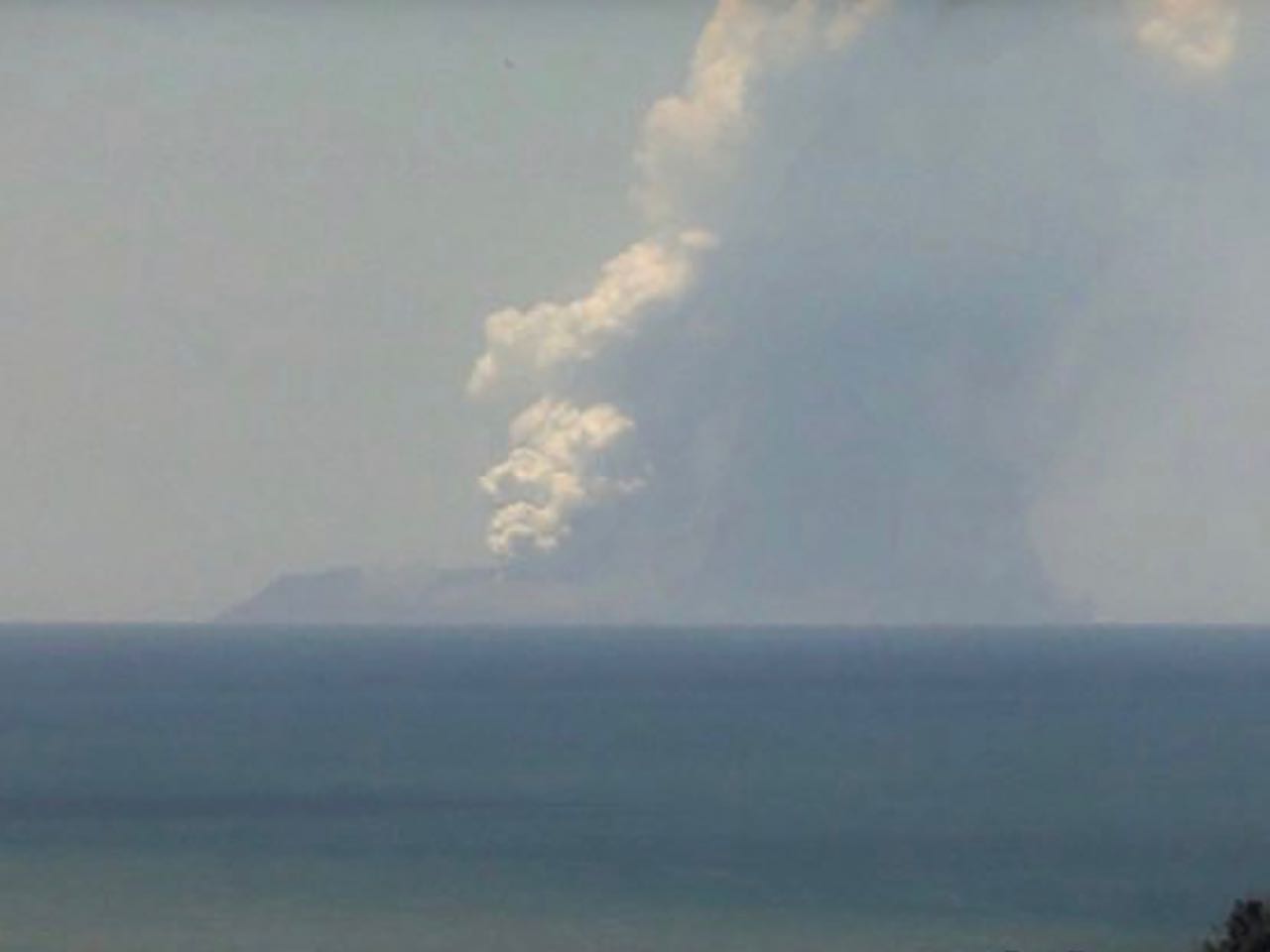 Whakaari/White Island at 2.20pm, 9 December 2019. Image: GNS
Whakaari/White Island at 2.20pm, 9 December 2019. Image: GNS
Tāpoi Te Moananui ā Toi | Tourism Bay of Plenty chief executive Kristin Dunne recalls a day of “shock and disbelief” as Whakaari/White Island erupted a year ago, eventually claiming the lives of 22 tourists and tourism workers.
When Whakaari White Island erupted on 9 December 2019 at 2.11pm, we each experienced the devastating natural disaster through a different lens.
This is the window through which I experienced the disaster in my role as tumuaki | chief executive of Tāpoi Te Moananui ā Toi | Tourism Bay of Plenty.
I wish to acknowledge the bravery of the survivors, offer my deepest sympathy to the whānau of those who tragically passed and acknowledge huge respect for all that were involved in the rescue efforts and medical treatment of those affected.
To the team of Tāpoi Te Moananui ā Toi, you are incredible, and I could not be prouder of you.
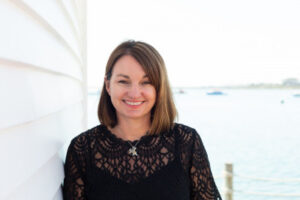
Kristin Dunne
Our Crisis Management Plan was on the agenda for sign-off at the Tourism Bay of Plenty Board meeting on 9 December 2019. By 2.15pm, the meeting was suspended, and the newly completed Crisis Management Plan was in action. Whakaari White Island was erupting.
Phone calls to industry colleagues confirmed our worst fears – manuhiri were on the island. Calls to the brave operators (who were mid-rescue efforts) confirmed our worst nightmare – there were multiple injuries and loss of life.
My legs went weak and a chilling cold swept over my body. I felt absolutely nauseated.
I stopped for a quiet moment to pray – “Dear God, please help them.” I repeated this simple prayer many times in the coming days.
I rang my parents who live on the coast. “White Island is erupting, but I don’t know how badly. Please go to my house inland so you are safe, and please pick up Caelan from school. I’m not sure when I will be home, but it won’t be tonight. I love you.”
Step 1 of the Crisis Management Plan – settle your family, make sure that they are safe so you can clear your head and concentrate on your job.
Our team and board huddled together. Everyone was in shock and disbelief, and tears rolled down some of our faces. We did a Karakia together. We agreed that we had a job to do, not that we knew what it was going to entail. I was in rare ‘command and control’ leadership style. Everyone was assigned a task.
The phones exploded. Journalists from outlets around the country and the world were wanting information and commentary. As our comms team prepared a holding statement, I remembered a tool from crisis media training called “put your C.A.P. on” – which means Care, Action, Perspective.
As the journalists’ questions were posed, my brain filtered what we knew “unofficially” out. I tried not to lie and instead say, “we have no official information yet”, but inside I knew there was so much more of the story that was yet to be told.
It was not my role to release information, and I was so cognizant of the panic-stricken families who deserved the full facts from official sources. It took too long to establish an official source, which exasperated media desperation. With a holding media statement in place, I handed my phone to a colleague to answer, whilst we re-grouped on what we knew, and made a plan for the next few hours.
Our cruise manager called. I had almost forgotten that the cruise ship Ovation of the Seas was in port with more than 4000 passengers on board.
This was our second disaster alongside Royal Caribbean Line. In 2016, a passenger was killed on a cycle tour, and a coach of passengers crashed (escaping injury) within half an hour of each other. We worked through that disaster together in partnership and the care RCL showed then was extraordinary.
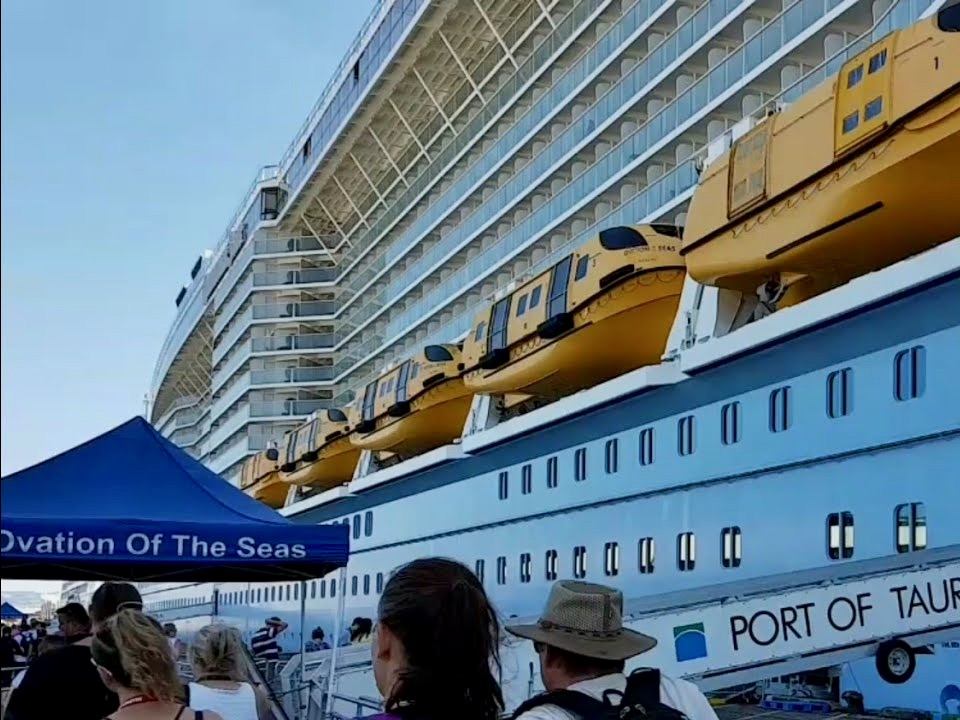
The Ovation of the Seas berthed at Tauranga earlier in 2019.
We started a crisis control centre in our boardroom. Crisis roles were established, butcher paper zones were created on the walls covering communications, stakeholders, risks, team welfare and more. Post-it notes started to fill the zones. Tasks were agreed, assigned and documented. We got supplies in for the team who would be working from the boardroom that night.
Once we had ascertained that there was no threat to the Whakatāne township, some of the team were dispatched to Whakatāne to help. Our board chair and the then mayor of Tauranga went, too.
No-one slept that first night and my team witnessed scenes in Whakatāne that will haunt them forever. Perhaps they shouldn’t have gone? Whether that decision was right or wrong bothers me still.
A team member and I went onboard Ovation of the Seas. By now we knew (unofficially) that this was the second epicentre of the disaster. Thirty-eight passengers were missing. A lot of things broke my heart that day, but learning children were still in the ‘kids club’ as their parents had not returned from their day trip was harrowing.
We joined the captain and his team of officers on the bridge. We explained how we thought we could help, and they welcomed us into the ranks of their team. There was butcher paper on the captain’s boardroom table too. They had a map of New Zealand and had marked in vivid pen the locations of the hospitals, and beside the map were the photos and names of the passengers who were missing. We had one objective: find the missing passengers and be able to give some answers to their distressed families all around the world. We worked under strict confidentiality.
Some victims had arrived in Whakatāne Hospital and others were transferred to Auckland, Hamilton, Wellington, and Christchurch. There was no central register to inform the transfer of those who were on the island. The DHBs can’t give out information by phone. In many cases patients had no identification on them, or due to their extensive injuries, were unidentifiable.
RCL dispatched representatives to each hospital and slowly but surely, we started to fill in the map with the passengers’ locations. Through the night, many of the missing were accounted for. It was harrowing work for the RCL staff out in the field. But at least we could start sending family and friends from the ship to their loved ones.
Local cruise tour operator Shore Trips & Tours worked through the night, and for free, taking kin to wherever they needed to be. The RCL care team started working to bring family from overseas to New Zealand and we called out to our friends at Air New Zealand and our RTO colleagues who would be welcoming manuhiri into their regions for help.
A huge operation was underway in Whakatāne, and we tried to connect the two epicentres. This was harder than it should have been. Eventually, after escalating the lack of communication to the minister of civil defence, representatives from the New Zealand Police and Civil Defence joined the ship to help co-ordinate and communicate between the two sites.
Meanwhile, 4795 passengers were stuck at the Port of Tauranga and the cabins of the missing needed to be sealed and forensically analysed, which we guessed would take some time. The ship remained in Tauranga for three days, with passengers getting increasingly frustrated and upset at the situation.
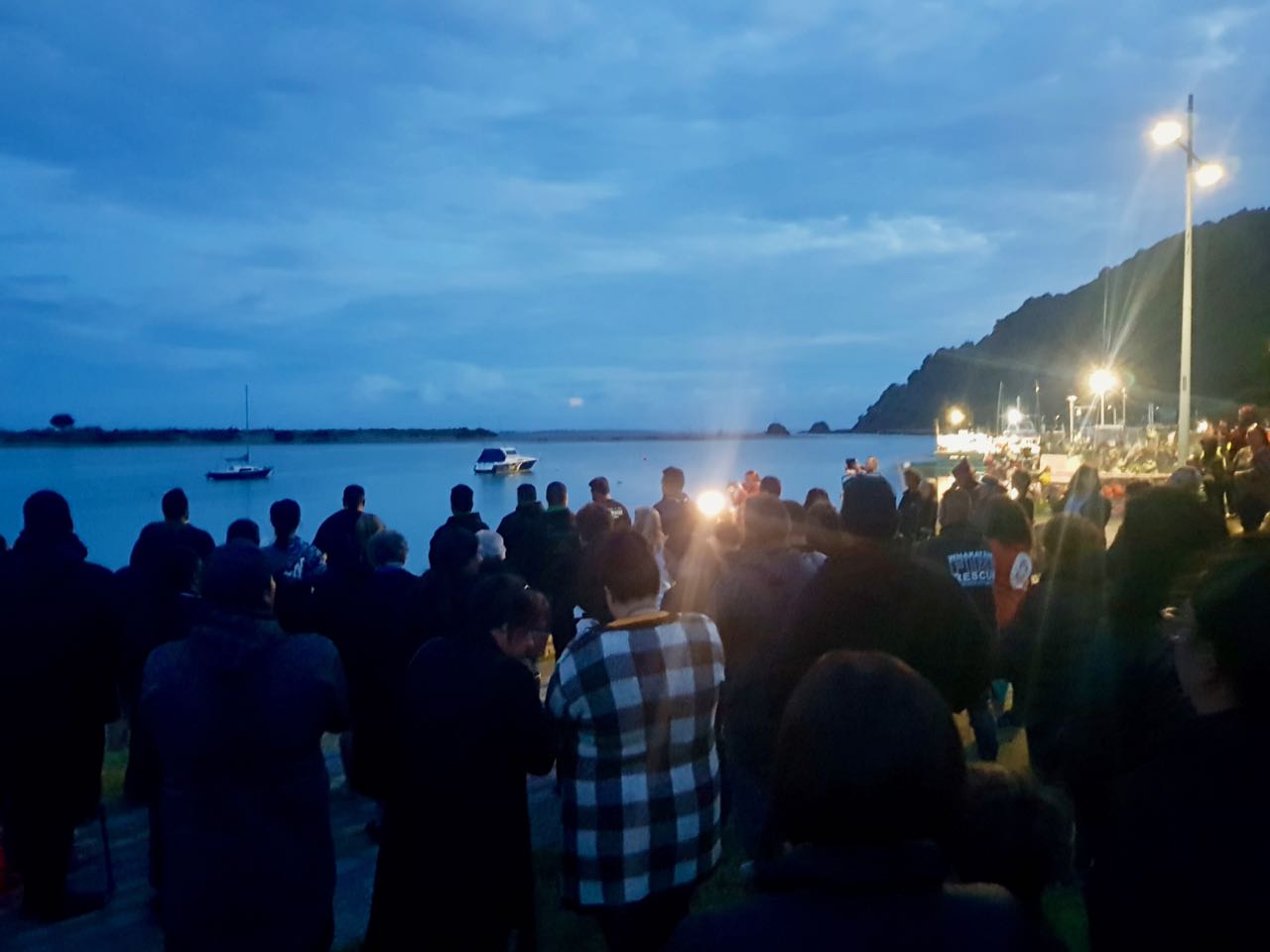 The early morning gathering on 13 December 2019 at Whakatāne Riverside giving karakia, waiata and support to the recovery teams. Image: Lesley Immink
The early morning gathering on 13 December 2019 at Whakatāne Riverside giving karakia, waiata and support to the recovery teams. Image: Lesley Immink
We worked with local iwi Ngāi Te Rangi who performed a Karakia Tau Te Mauri (prayer vigil) in honour of the victims and the community of Whakatāne. The media also got increasingly frustrated at the lack of information and so we negotiated with the port and RCL to bring the media pack inside to film the karakia under strict conditions. Passengers crowded the decks to watch. It was a beautiful moment to honour those that had not returned to the ship.
Following that, I returned to the office to regroup with the team, check on everyone’s location and welfare, update the team’s tasks and then departed for Whakatāne to join the on-site team. Someone had to drive me as my phone never stopped ringing and I hadn’t slept.
We realised that the information that we held onboard the ship was more up-to-date than the ‘official information’ in Whakatāne and a central source of truth needed to be established.
The injured were moved around the country and between many organisations it was difficult to keep families informed and re-unite them with their loved ones. Some family members arrived from overseas and went to each hospital themselves, desperate to find their loved ones. That seemed unacceptable. Their medical status also changed all the time.
So, after an escalation to the Regional Emergency Management Agency, a Welfare Co-ordination Centre was established in Whakatāne District Council and RCL and ourselves sat on that group to help update (usually heart-breaking) information that was ever-changing.
The Whakatāne crisis centre inside Whakatāne District Council was also the media centre. It wasn’t hard to tell that the communications between various departments and organisations were not going well. We brought in Scott Campbell from Campbell Squared to assist and my whole comms team worked tirelessly alongside them to try and bring timely, accurate and well-prepared information to the nation, and the many other nations watching.
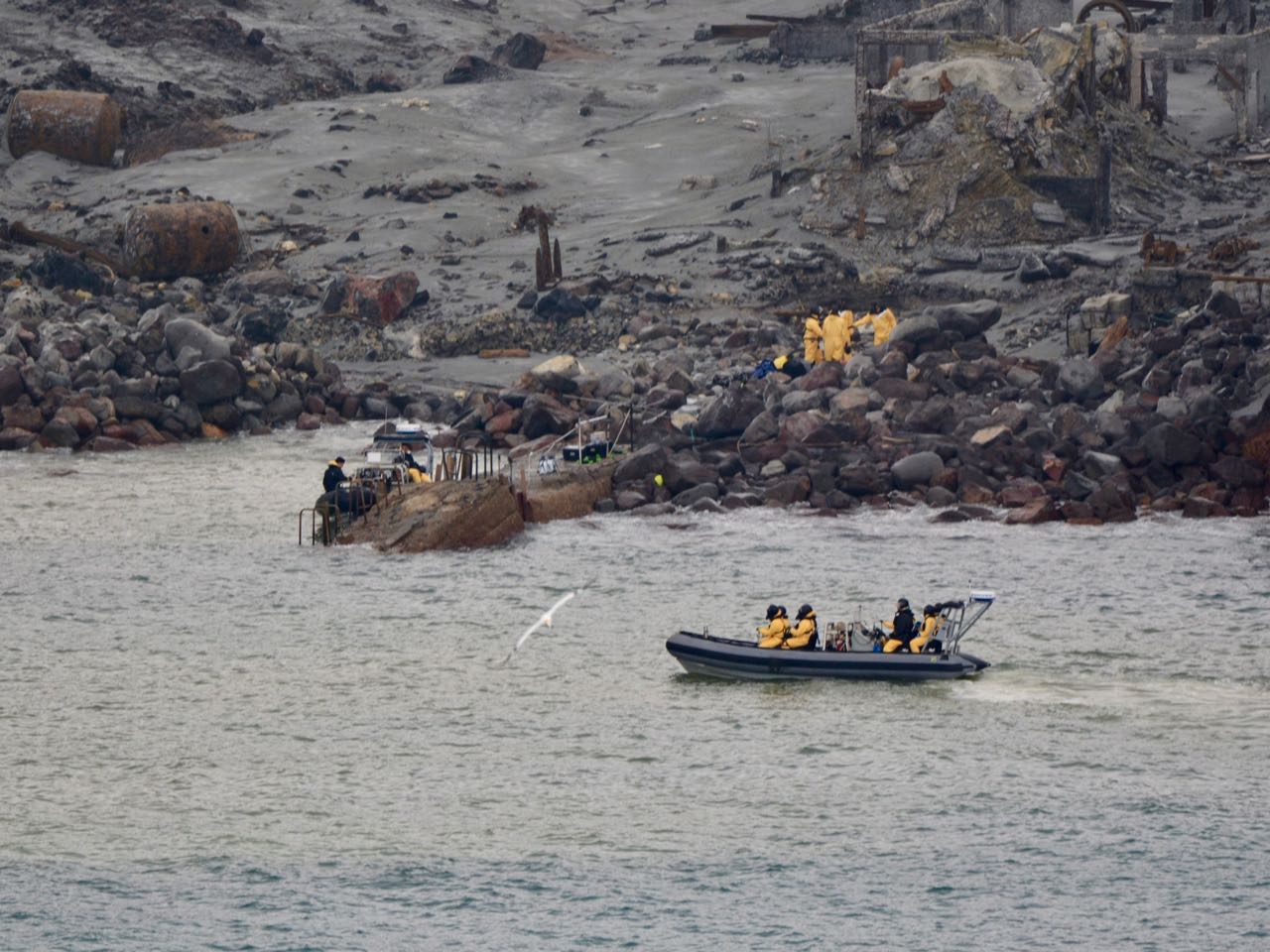 NZ Defence Force personnel on Whakaari/White Island on 13 December 2019. Image: NZDF
NZ Defence Force personnel on Whakaari/White Island on 13 December 2019. Image: NZDF
Once confirmed, the retrieval of the bodies of the deceased on Whakaari then became the focus for us, and getting the affected families to Whakatāne as this happened. The decision was made late in the day to attempt the retrieval on 13 December. A phone call to Duane Emeny at Air Chathams produced a late-night charter flight to fly the families in.
Whatever we needed, we only had to reach out to a local contact and it was sorted. The shell-shocked industry came together, and nothing was too much trouble.
We also needed to keep all details highly confidential to keep the victims and their families’ privacy protected and let them process their grief without the glare of media. The national industry sent their awhi also; Tourism New Zealand came to town and the Visitor Sector Emergency Advisory Group (VSEAG) was stood up.
We worked with the New Zealand Police victim support team and the Australian Consulate to pick up the families from Whakatāne Airport and local Ngāti Awa-owned accommodation White Island Rendezvous welcomed them with open arms. It was late when they arrived and I recall McDonald’s being all we could find for our manuhiri for dinner that night.
We negotiated spaces for the international families to join the local families onboard a White Island Tours boat for the waiata and blessing at dawn the following morning. McDonald’s was also all we could provide for breakfast. No one had much of an appetite in any case.
The vessel took the families out to sea to view the island from a safe distance to help them in their grieving process. Once the families returned, deeply moved by the waiata experience led by Ngāti Awa, the New Zealand Police victim support team and I helped to quietly move the families to the Whakatāne Airport, where we waited together for news of the returning bodies.
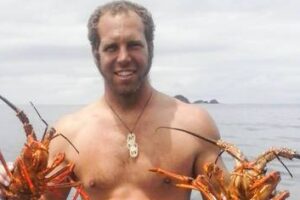
White Island Tours guides Hayden Marshall-Inman (pictured) and Tipene Maangi were among the 22 fatalities.
Eventually, choppers started coming overhead and we were updated that six of the bodies had been retrieved, but two had not. Which two…?
There wasn’t time for the formal identification processes. Once the bodies were decontaminated, they were placed in coffins and, with the support of incredible Ngāti Awa tikanga and the aroha of everyone involved in the retrieval operation, the families said goodbye to each coffin, unsure which contained their loved one. Or whose loved one was still missing.
We supported RCL to arrange flights for the families to follow their loved ones to Auckland for the formal identification and repatriation processes of those who had not survived the eruption. And as we said goodbye, we hugged, for they were now our whānau, too.
It is even more tragic that Covid-19 has meant that the international families cannot join Whakaari He Rā Whakamauharatanga (the Whakaari Anniversary) in-person. For the international families who had lost loved ones on foreign shores, experiencing the Te Ao Māori approach to tragedy and death was hugely impactful and helped to cushion the devastating loss in those first few days.
Hopefully, in 2021 we can once again awhi and share deep aroha with our special manuhiri who will never be forgotten.
To help me lead in this crisis, Ngāti Rangi gave me this Whakatauki which I taped to my office door during the darkest days of my career:
Kia kaha, kia maia, kia manawanui.
Keep strong, keep brave and keep steadfast.
It is still on my office door.